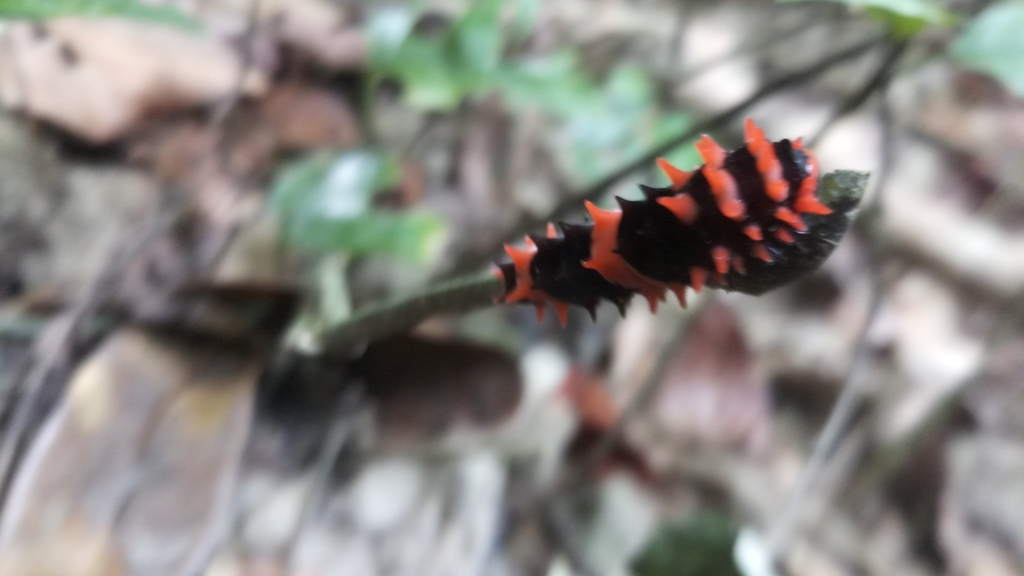Losaria rhodifer, formerly known as Papilio or Atrophaneura rhodifer, is found on Andaman and Nicobar islands. More sources refer to it as the Andaman Clubtail than as the Nicobar Clubtail; both names are used.
"Rhodifer" can be translated as "one who carries something red." One of the later assigned species names in this genus, it commemorates a contemporary family name rather than a character from ancient literature, but it seems appropriate since the butterfly's spatulate "swallowtails" carry red dots. Or, in the case of the individual shown above, faded-to-pink dots. The wingspan is about five inches. In 1903 F. Moore wrote that the rhodifers he had found measured 4-3/4 to 5-1/4 inches, males being five inches and over, females five inches and under.
Some writers have apparently claimed that rhodifer was rare and endangered in India, but it seems never to have been native to the mainland at all. In Nagpur, where one confused enthusiast put it, it is as exotic and out of place as the enthusiast would probably be at a university. On its native islands it's not especially rare. There aren't a lot of these butterflies on Earth. Probably there wouldn't be any if the islands were deforested. But nature seems to intend that there not be very many of some lifeforms, especially large insects. We have to coexist with relatively few of them in order to conserve the ones we have.
Photo from the official Butterflies of India website: https://www.ifoundbutterflies.org/#!/sp/1048/Losaria-rhodifer
People on the islands are aware that the butterflies are among their main tourist attractions. Note the creative use of a free web site to market the "Andamans: Paradise on Earth" concept:
These people aren't even shy about showing themselves as attractions. Well, some of them are demonstrating things to do, and others are presumably tour guides and lecturers...but you can see that they'd just love to meet you. They appreciate the artistic merits of US and Canadian currency, too, no doubt. But they deserve credit for keeping at least parts of the islands Green. We wouldn't want them ever to cut down the trees, pave the ground, and put in parking lots. The whole photo gallery is gorgeous.
Indians can even get college credit for studying what's been written about these butterflies:
Many people in India find the quirky symmetry of rhodifer's wings especially pleasing to the eye. Losaria rhodifer was one of the first Indian butterflies to be featured on a postage stamp. Note that the female Papilio mayo, top right, looks more like the Losaria couple, below, than like her own mate, top left. Butterflies do that kind of thing. They are all about faking out hungry birds. They have no family loyalty, no shame...
Ayushi Prakash's top eight list of India's most memorable butterflies includes rhodifer, along with the beloved Crimson Rose, the jewel-colored Kaiser-i-Hind, and the super-size Birdwing.
Nevertheless, Indian scientists warn, "the habitat of these butterflies is continuously being degraded" as people continue to think that surely just one more section of forest can be sacrificed to build just one more of...
The question has been raised whether rhodifer is just another subspecies of Losaria coon. Visible differences don't always add up to species differences. In some species males and females look completely different. In Losaria rhodifer males and females look pretty much alike, but both the color pattern on the hind wings and the shape of the "swallowtails" are different enough from coon that anyone can tell them apart by looking at them. Here pictures of each species appear side by side:
Etsuzo Tsukada's Butterflies of the Southeast Asian Islands notes that rhodifer looks different under different weather conditions, and illustrates "spring and summer" forms. Islanders consider them uncommon, but likely to be seen, in December:
A quirk found on some female Losaria is an ornamental plate or knob at the tail end called a sphragis. In some longer-lived butterfly species, like the Monarchs, a female normally mates two or three times. In shorter-lived species, like the Atrophaneuras, a female normally mates only once. In a few species, sphragides form, apparently by an interaction between male and female bodies in the mating process, to serve as badges indicating that a female has already mated. Though some smaller butterflies form quite large sphragides, the sphragis does not seem to affect the butterfly's longevity or ability to fly, and may or may not even prevent a second mating. The sphragis has been the topic of a study, which notes that the Losarias, which are relatively large butterflies, form relatively small sphragides. (Other Atrophaneuras don't seem to have this feature, but the sphragis was first observed in the genus Parnassius and is found in some other butterflies in the swallowtail family.)
Most moths and butterflies mate back to back, being careful not to bump wings. Some of the Atrophaneuras are exceptions; not this pair of rhodifer. Several photographers have snapped pictures of couples holding their wings so high overhead that they look as if they might be standng on their heads (they're not) to avoid damage to those "clubtails."
The female butterfly then lays her eggs, not on an Aristolochia, but on Thottea tomentosa. This plant, like the butterflies, is found in evergreen forests.
The caterpillar differs from other red-bodied swallowtail caterpillars, slightly, by having distinct red and black colors rather than being reddish-black all over. It's still designed to look maximally unappetizing.
Photos of the pupa, and data on the butterflies' life expectancy, and other information have undoubtedly been published soewhere but don't seem to be available online.





No comments:
Post a Comment